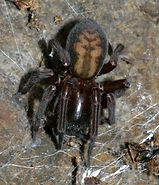
Spiders
Spiders, with their eight legs and often mysterious appearances, evoke a range of reactions from people. While some find them fascinating, others feel uneasy or even fearful around them. Whether you belong to the former or latter category, it’s essential to maintain control over spider populations in your home. In this blog, we'll explore some practical tips for controlling spiders and creating a spider-friendly environment. ProGuard Pest Control is here to help control these pests and help keep them from entering your home.
Spiders in Northwest Ohio

House Funnel Weaver:
House funnel weaver spiders, scientifically classified as Tegenaria domestica, are commonly encountered arachnids in human dwellings across North America and Europe. These spiders are characterized by their funnel-shaped webs, constructed in corners and crevices to trap prey. Typically brown or gray in coloration with a leg span reaching about an inch, they possess a rather nondescript appearance. Despite their formidable size and web-building prowess, house funnel weavers are generally harmless to humans, preferring to retreat rather than confront. Encouraging natural predators and maintaining a clutter-free environment can help manage their presence without resorting to harsh chemicals.

Hackled-Mesh Weaver:
The hackled-mesh weaver spider, scientifically known as Amaurobius ferox, is a fascinating arachnid species found in various habitats across Europe and North America. These spiders are distinguished by their intricate web structures, which resemble tangled mesh and are often constructed in dark, secluded areas such as basements, attics, and woodpiles. With a body length ranging from 6 to 12 millimeters, hackled-mesh weaver spiders are relatively small and inconspicuous. Despite their fearsome appearance, they pose minimal threat to humans, preferring to feed on small insects and other arthropods. Maintaining a clean and clutter-free environment can help reduce their presence indoors, while preserving natural habitats outdoors supports their role in ecological balance.

Barn Orb Weaver:
The barn orb weaver spider, scientifically referred to as Araneus cavaticus, is a common arachnid species often found in agricultural areas and rural settings across North America. These spiders are recognized for their distinctive orb-shaped webs, which they spin to capture flying insects like mosquitoes and flies. With a body length typically ranging from 6 to 20 millimeters, barn orb weavers exhibit varying shades of brown and yellow, aiding in camouflage against their surroundings. Despite their formidable appearance, barn orb weavers are generally harmless to humans and contribute to natural pest control in agricultural environments.

Furrow Orb Weaver:
Furrow orb weaver spiders, scientifically known as Larinioides cornutus, are intriguing arachnids commonly found in wetland habitats throughout North America and Europe. These spiders are named for the furrow or indentation found on their abdomen, which distinguishes them from other orb weaver species. Furrow orb weavers construct intricate orb-shaped webs, often positioned near bodies of water or in marshy areas, to ensnare flying insects like mosquitoes and midges. With a body length typically ranging from 5 to 15 millimeters, furrow orb weaver spiders exhibit various shades of brown, gray, and yellow, aiding in their camouflage amidst vegetation.

Parson Spider:
Parson spiders, scientifically known as Herpyllus ecclesiasticus, are widespread arachnids found throughout North America. These spiders are named for their distinctive black and white markings, reminiscent of the traditional attire worn by parsons. Parson spiders typically measure between 6 to 20 millimeters in body length, with long legs that aid in their swift movements. While they may appear intimidating, parson spiders are harmless to humans and primarily prey on insects, making them beneficial members of the household ecosystem.

Wolf Field Spider:
Wolf field spiders, scientifically classified as Pardosa spp., are a diverse group of arachnids commonly found in fields, meadows, and grasslands worldwide. These spiders are adept hunters, using their keen eyesight and agility to chase down prey such as insects and small arthropods. With a body length typically ranging from 3 to 15 millimeters, wolf field spiders vary in appearance and coloration, often blending seamlessly into their natural surroundings. Despite their ferocious name, wolf field spiders pose no threat to humans and play a crucial role in controlling pest populations in agricultural ecosystems.

Yellow Sac Spider:
Yellow sac spiders, scientifically referred to as Cheiracanthium spp., are a widespread species found in various habitats across the globe, including North America, Europe, and Asia. These spiders are named for their distinctive yellow to pale-green coloration and their habit of constructing silken sacs for shelter. With a body length typically ranging from 5 to 10 millimeters, yellow sac spiders are relatively small but possess venomous fangs used to immobilize their prey. While they primarily feed on small insects and other arthropods, yellow sac spiders are known to occasionally bite humans, resulting in mild irritation or discomfort.

Black Widow Spiders:
Black widow spiders, scientifically known as Latrodectus mactans, are infamous arachnids primarily found in temperate regions around the world, particularly in North America. These spiders are easily recognizable by their shiny black bodies with a distinctive red hourglass marking on the underside of their abdomen. With a body length ranging from 3 to 10 millimeters, female black widows are larger and more venomous than males. Their venom contains neurotoxins that can cause severe reactions in humans, although fatalities are rare with prompt medical treatment.
%20(7).png)